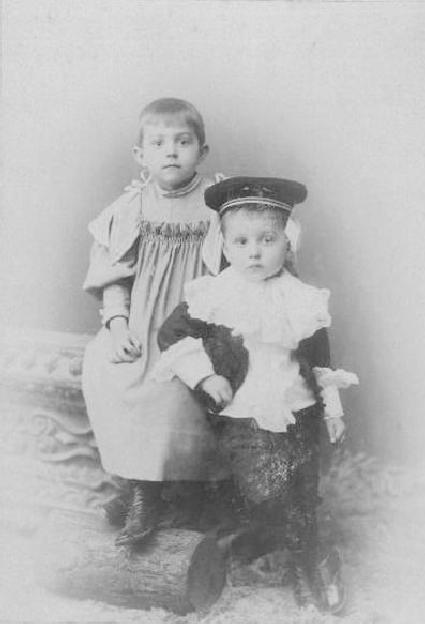
Figure 1.--These children wee photographed in Atlantic City, New Jersey about 1890. They both look like boys. Note that the older child wears a dress. This suggests to us that the older child must be a girl. |

|
One clothing historian believes that the Fauntleroy suit was an important factor in ending the centuries old convention of dressing younger boys in dresses. She speculates that mothers were so anxious in the lare 1880s and 90s to dress their sons in Fauntleroy outfits that they breeched them earlier than they might have. Of course there were skirted options such as a Fauntleroy dress of a Fauntleroy kilt suit. Even so, the standard Faunteroy suit as decribed and depicted in the book was a knee pants suit. And that was what most mothers wanted for their sons. We do not have any written evidence supporting this thesis from the late-19th century. We do, however, have a very lsrge archive of historical images. The problem is thst most of them do not identify the individuals making it difficult to assess gender. Not only do we have individual and small group portraits, but we also have whole family images. Even with out names, it seems that once boys were dressed in knee pants Fauntleroy suits that they no longer wore dresses. Thus it does seem that Fauntleroy suits accelerated the age of breeching. To what extent this influenced the decline of the comvention of boys wearing dresses and other skirted garments, we are not ebntirely sure.
One clothing historian believes that the Fauntleroy suit was an important factor in ending the centuries old convention of dressing younger boys in dresses. This seems to us an over statement. But we beliece that the Fautleroy Craze was a factor. She speculates that mothers were so anxious in the lare 1880s and 90s to dress their sons in Fauntleroy outfits that they breeched them earlier than they might have. Of course there were skirted options such as a Fauntleroy dress of a Fauntleroy kilt suit. For whatever reason we see more Fauntleroy kikt suits than Fauntleroy dresses. Even so, the standard Faunteroy suit as decribed and depicted in the book and worn in America was a straight-leg knee pants suit. Bloomer knickers were more common in Britain. The knee pants suit was what most American mothers wanted for their sons. To what extent this influenced the decline of the comvention of boys wearing dresses and other skirted garments, we are not entirely sure. We know of no way of proving this with any certainty.
It should not be thought that the Fauntleroy Craze was the only fashion development at play at the time. In the early 19th century younger boys wore basically the same styled dresses as rheir sisters. This began to change after midicentury when boy syled dresses began to appear as well as the kiltsuit. And we see the age range beginning to narrow. with fewer olderbboys earing dresses. We do not have any written evidence supporting this thesis from the late-19th century. We do, however, have a very large archive of historical images. The problem is thst most of them do not identify the individuals making it difficult to assess gender. Not only do we have individual and small group portraits, but we also have whole family images. Even with out names, it seems that once boys were dressed in knee pants Fauntleroy suits that they no longer wore dresses. Thus it does seem that Fauntleroy suits accelerated the age of breeching, but certainly did not cause rhe deckine of the dress conventiin.
An interesting question is why after centuries of little boys wearing dresses did this convention decline in the late 19th century and rapidly disappear after the turn-of-the 19th entury. Now if this only begun with Fauntleroy craze than the would know that this was the primary cause, but we see the cinvention beginning the change before the 1880s. But we begin to see the changes beginning before this. We note a range of boyish touches in the dressess, the most importahnt being that the dresses boys wire began to becoming more plsin thn the om=nds orn bu=y their sisters. the populrity of the kilt suit seems to hbe been part of that trend. The kilt suit was a boy's style, girls did not wear them. Then about 1895 there is a devided decline in the convention of boys wearing dresses. There has been specultion as to why. Often laundrey and toilet trsining have been proposed as a reason. Skieted harments are a more efgucent garment for boys not yet toilet trained. This may habe been a factor,nespecislly in the 20th century, but we believe more wa involved. The fact that the first step in thiud process was biy styled sresses and kilt suits suggests thst the major caise was that for what ever reason, ther was incresing sentiment that boys, even very young boys, should not be dressed like girls. What caused this new sentiment, we are not at all sure.
Navigate the Boys' Historical Clothing Fauntleroy related pages:
[Return to the Main U.S. Fauntleroy page]
[Return to the Classic Fauntleroy page]
[Fauntleroy dresses]
[Lace collars]
[Vivian Burnett]
[Fauntleroy patterns]
[Classic materials]
[Classic hair styles]
[Individual classic suits]
Navigate the Boys' Historical Clothing other related pages:
[Dresses]
[Breeching]
[Kilts]
[Smocks]
[Pinafores]
[Sailor Hats]
[Blouses]
[Ring Bearers]
[Long hair]
[Ringlet curls]
[Hair bows]
[Bangs]
[Collars]
[Bows]
Navigate the Boys' Historical Clothing Web Site:
[About Us]
[Introduction]
[Activities]
[Biographies]
[Chronology]
[Clothing styles]
[Countries]
[Girls]
[Theatricals]
[Bibliographies]
[Contributions]
[FAQs]
[Glossaries]
[Images]
[Index]
[Links]
[Registration]
[Tools]
[Main HBC Topic page]
[Boys' Historical Clothing Home]
